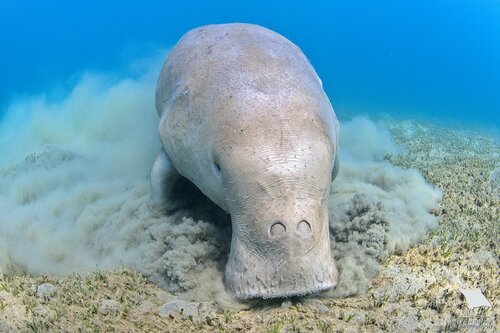
Dugong
Dugong dugon, a gentle giant of the sea, gracefully grazes on seagrass in warm coastal waters. With its distinctive whale-like tail and downturned snout, the dugong is vital for seagrass bed health, embodying the delicate balance of marine ecosystems.
150.0 - 400.0 kg
Weight
Length: 2.7 - 3.0 m
Size
Brown, Grey
Color
13 mph
Top Speed
Vulnerable
Conservation Status
Decreasing
Population Trend
Characteristics
Dugongs are marine mammals residing in warm coastal waters, primarily in the Indo-Pacific region. They have a fusiform body with a fluked tail, similar to a whale, and a downturned snout suited for grazing on seagrass. Dugongs are notable for their gentle nature and are often referred to as 'sea cows'. They play a crucial role in maintaining healthy seagrass ecosystems.
Distribution Range of the Dugong
The Dugong (Dugong dugon) is native to the coastal and marine waters of the Indo-Pacific region. This includes the eastern coast of Africa, throughout the Red Sea, the waters surrounding the Indian subcontinent, and the coastal areas of Southeast Asia, extending as far east as northern Australia and Papua New Guinea.
Dugong's Habitat
Environmental Conditions
Dugongs primarily inhabit shallow, warm coastal waters where seagrass beds are abundant. They are typically found in sheltered bays, mangrove channels, and the waters around islands and reefs. These areas often feature a tropical or subtropical climate, with water temperatures generally ranging from 20 to 30 degrees Celsius.
Ecological Niche
Dugongs are herbivorous marine mammals that play a crucial role in maintaining the health of seagrass ecosystems. They feed almost exclusively on seagrass and are adapted to a slow-moving lifestyle within these underwater meadows. Their grazing habits help to keep seagrass beds healthy by promoting growth and preventing overgrowth that could lead to decreased biodiversity.
Copyright @ Nature Style Limited. All Rights Reserved.
 English
English